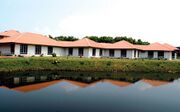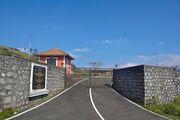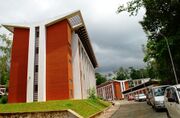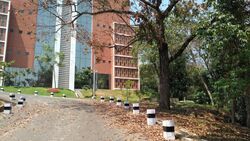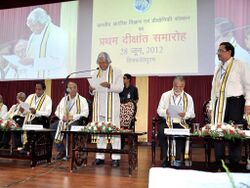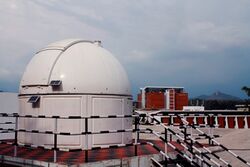Indian Institute of Space Science and Technology
Topic: Organization
 From HandWiki - Reading time: 9 min
From HandWiki - Reading time: 9 min
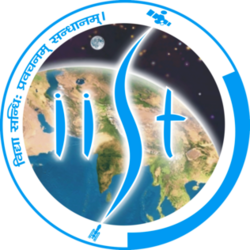 | |
| Motto | विद्या सन्धि: प्रवचनम् सन्धानम्। (Sanskrit) |
|---|---|
| Type | Deemed University[1] |
| Established | 2007 |
Parent institution | Indian Space Research Organisation |
| Chancellor | B. N. Suresh[2] |
| Director | S. Unnikrishnan Nair |
Academic staff | 103[3] |
| Students | 1,021[3] |
| Undergraduates | 584[3] |
| Postgraduates | 207[3] |
| 230[3] | |
| Location | Thiruvananthapuram , Kerala , India |
| Campus | 100 acres (0.4 km2)[4] |
| Website | iist |
Indian Institute of Space Science and Technology (IIST) is a government-aided institute and deemed university for the study and research of space science, located in Thiruvananthapuram,India. IIST was set up in 2007 by the Indian Space Research Organisation (ISRO) under the Department of Space, Government of India.[5]
It was inaugurated on 14 September 2007 by G. Madhavan Nair, the then Chairman of ISRO.[6] A. P. J. Abdul Kalam, former President of India, was the first Chancellor of IIST.[7] IIST offers regular engineering undergraduate, postgraduate and doctorate programmes with focus on space science, technology and applications.
History
Envisioned to fulfill the requirements of scientists and engineers in the Indian Space Program, by offering undergraduate and postgraduate education and research programmes in space science and technology, the institute started functioning from the Vikram Sarabhai Space Centre (VSSC) campus, Thiruvananthapuram, on 14 September 2007 with an initial investment of ₹270 crore (equivalent to ₹656 crore or US$92 million in 2019) and annual recurring cost of ₹40 crore (US$5.6 million) by the Department of Space.[8] It is the only institute of its kind in India, which offers a BTech degree in Space Technology, and subjects exclusive to the arena of space science and technology.[9][10] B. N. Suresh, former director of Vikram Sarabhai Space Centre, is the founding director of the institute.
On 14 July 2008, the Union Human Resource Development Ministry, on the advice of the University Grants Commission (UGC), conferred deemed university status, under a new category, to the institute for a period of five years.[11][12]
Campus
At its inception, the institute started functioning at the ATF Campus, under Vikram Sarabhai Space Centre, Thiruvananthapuram (Trivandrum), Kerala. Modern environmentally friendly buildings of unique architecture merge well with the thickly wooded campus of 100 acres situated on the foothills of Sahyadri.
A state-of-the-art residential campus built near Liquid Propulsion Systems Centre in Valiamala, Nedumangad, Thiruvananthapuram was inaugurated by Manmohan Singh, the then Prime Minister of India on 25 August 2009.[13] The institute started functioning in its new campus from 15 August 2010. The campus has an extension in the picturesque Ponmudi Hills, Thiruvananthapuram, for an observatory.
Academics
IIST offers undergraduate (BTech), master's (MTech) and PhD programs in space science and technology, and also serves as a research centre.[5] Doctoral programs in basic sciences and post-doctoral programs are also offered.[14] Till 2013 batch, three different courses in BTech were offered, namely BTech in Aerospace, Avionics and Physical Sciences. As of 2014 admissions, a new 5-year Dual Degree (BTech + MTech/M.S) in Engineering Physics replaced the existing Physical Sciences branch. The MTech/M.S can be done in any of the following – M.S. in Astronomy & Astrophysics, MTech in Earth System Science, MTech in Machine Learning and Computing, MTech in Geoinformatics, MTech in Aerodynamics & Flight Mechanics, MTech in Structures and Design, MTech in Thermal and Propulsion, MTech in Control Systems, MTech in Digital Signal Processing, MTech in RF and Microwave Engineering, MTech in Power Electronics, MTech in VLSI and Microsystems, MTech in Material Science and Technology, MTech in Solid State Physics and MTech in Optical Engineering. The seats are limited to 20 in the dual degree program from the existing 36 in Physical Sciences. 60 students each are admitted to the Aerospace and Avionics branches.
Admissions
The admissions to the undergraduate (BTech) programmes for 2013 to 2016[15] were made through the All India Rank List prepared and published by the Central Board of Secondary Education (CBSE), based on the Joint Entrance Examination (JEE) – Main. Previously, IIST admitted students through the IIT-JEE rank lists from 2007 to 2009, and conducted its own entrance exam called ISAT[16] from 2010 to 2012. However, applicants will need to qualify the JEE Advanced exam, and marks obtained in the same will be used in determining the eligibility of the candidate[17] IIST offers 140 seats for admission to its B.Tech. programmes in aerospace engineering, avionics and engineering physics. The BTech branch of physical sciences was replaced with a dual-degree (BTech and MTech) engineering physics branch starting from the batch which joined in 2014. Over 100,000 aspirants applied for these seats in ISAT 2012 making IIST one of the most selective institutes in India . From 2017 onwards, the admissions are based on JEE Advanced scores.
The applications for admission to MTech courses[18] are invited directly and students are shortlisted based on undergraduate academic performance, GATE score, interview and projects undertaken by them.
Departments
Science
- Department of Mathematics
- Department of Physics
- Department of Chemistry
- Department of Earth and Space sciences
Technology
- Department of Aerospace Engineering
- Department of Avionics
Humanities
- Department of Humanities
Rankings
Template:Infobox India university ranking Indian Institute of Space Science and Technology was ranked 48 by the National Institutional Ranking Framework (NIRF) engineering category 2023.[19]
Observatory
IIST also has a small observatory on campus equipped with a 14-inch Schmidt-Cassegrain telescope and an 8-inch Newtonian telescope.[20] The telescope is housed in a dome on top of the Science academic block (also called as the D2 block). The facility is mainly used by undergraduate and postgraduate students as well as for frequent vacation-based outreach programs.[20] The dome is powered by two sets of solar panels with necessary back-up power.
Student activities
Student projects
VYOM ('sky' in Sanskrit) is the Sounding Rocket designed by the BTech students of IIST. Vyom had its maiden flight on 11 May 2012 when it took to the sky from TERLS. and the mission was a total success. The objective of the launch was to flight-test the solid rocket motor and the accelerometer payload developed for the project.[21] Vyom is the first student made sounding rocket in Asia and the Vyom Mk II was planned for launch in 2015.[22] IIST also runs a student satellite project, which is also slated for launch in 2014–2015 on board the PSLV.
IEEE Student Branch at IIST
IIST has an active IEEE Student Branch established in 2011. It now has seven organizational sub units including the following student branch chapters:
- IEEE Industrial Applications Society (IAS) Student Branch chapter
- IEEE Antennas and Propagation Society (APS) Student Branch chapter
- IEEE Microwave Theory and Techniques Society (MTTS) Student Branch chapter
- IEEE GRSS Student Branch chapter
- IEEE SIGHT Group Student Branch chapter
- IEEE Education Society (EdSoc) Student Branch chapter
- IEEE RFID Council Student Branch Chapter
Student festivals
The following student festivals are organised at IIST every year.
Conscientia
Conscientia is the Annual Astronomy and Technology Festival of IIST.[23] Conscientia offers various challenging events in different fields of engineering and science, including astronomy, aerospace engineering, electronics, computer science, mechanical engineering, robotics, etc. In the year 2010, the astronomy festival Aparimit has been incorporated into Conscientia. The 2010 edition[24] was inaugurated by IIST's Chancellor, A. P. J. Abdul Kalam, former President of India.[25] In just a few years, Conscientia has evolved to become the largest technical festival in the state of Kerala.[26] The 2014 edition of the festival is going to start on 28 February 2014. The official website of the festival [2]
Dhanak
Dhanak is the Annual Cultural Festival of IIST. Named after the Urdu word for 'rainbow', it stands for the splash of colour and sunshine that this festival brings with it. It[27] spans all facets of cultural activity, including dramatics, fine arts, literature, quizzing, music, dance, film-making, and photography. The most awaited moment at Dhanak is the pronite, in which a DJ/Band is invited to perform. Dhanak 2015 witnessed DJ VH1 Supersonic. Progressive Brothers from DJ Sunburn gave their performance in 2016 and Masala Coffee, South India's largest band performed in Dhanak in 2017. Dhanak also features themes every year based on which the whole campus is decorated. The theme for 2018 was "comicolours".
IIST Model United Nations (IIST MUN)
Started as an intra-college event in March 2012, IIST MUN has now become a national inter-college Model United Nations with United Nations General Assembly council held successfully in September 2012, 2013, October 2014 and April 2015. It has become an annual event, with the 2019 event being the last one held before the Covid-19 pandemic. After a gap of 3 years, it was held in March 2023. The next edition is going to be held in February 2024.
International collaborations
IIST has signed a number of memorandums of understanding (MoUs) with international universities and Institutions for joint research, and exchange of students and faculty. These include Caltech-USA, Jet Propulsion Laboratory-USA,TU Delft -The Netherlands, University of Colorado, Boulder-USA, Technion-Israel, University of Cambridge-UK and Nanyang Technological University-Singapore.[28] A number of other collaborations are under discussions. The Satish Dhawan fellowship at California Institute of Technology was announced by K. Radhakrishnan, Chairman, ISRO on 3 June 2013.[29] The fellowship provides an opportunity every year starting from the winter session of the academic year 2013–14 to one meritorious graduating student from the Aerospace Department of IIST to be sponsored by the Department of Space, Government of India to pursue master's degree in aerospace engineering at the California Institute of Technology.[30][31]
See also
- List of engineering colleges in Kerala
- List of universities in India
- List of autonomous higher education institutes in India
- Department of Space (India)
- Indian Space Research Organisation
- Indian Institutes of Technology
- Indian Institute of Science
- Indian Institute of Astrophysics
- National Institutes of Technology
References
- ↑ "Indian Institute of Space Science and Technology". http://www.iist.ac.in/about-us/about-iist.
- ↑ "Chancellor | IIST". https://www.iist.ac.in/aboutus/chancellor.
- ↑ 3.0 3.1 3.2 3.3 3.4 "NIRF 2022". Indian Institute of Space Science and Technology. https://www.iist.ac.in/sites/default/files/nirf/NIRF-2022%20OVERALL.pdf.
- ↑ "Indian Institute of Space Science and Technology". http://www.iist.ac.in/about-us/campus.
- ↑ 5.0 5.1 "An educational hub in the making". The New Indian Express. 30 August 2009. http://www.expressbuzz.com/edition/story.aspx?Title=An+educational+hub+in+the+making&artid=VxZcdy2moX8=&SectionID=lMx/b5mt1kU=&MainSectionID=ngGbWGz5Z14=&SectionName=tm2kh5uDhixGlQvAG42A/07OVZOOEmts&SEO=.
- ↑ "A new trajectory". The Hindu Business Line. 24 September 2007. http://www.thehindubusinessline.com/2007/09/24/stories/2007092450671500.htm.
- ↑ "Kalam appointed IIST Chancellor". The Hindu. 9 September 2008. http://www.hindu.com/2008/09/09/stories/2008090956211300.htm.
- ↑ "Indian Institute of Space Science & Tech to take off on Sept 14". Financial Express. 31 August 2007. http://www.financialexpress.com/news/indian-institute-of-space-science-%26-tech-to-take-off-on-sept-14/213610/.
- ↑ "Beyond engineering and medicine". The Hindu. 20 April 2009. http://www.hindu.com/edu/2009/04/20/stories/2009042050240500.htm.
- ↑ "A launch pad for space scientists". The Hindu. 7 August 2007. http://www.hindu.com/edu/2007/08/07/stories/2007080750010100.htm.
- ↑ "Indian Institute of Space Science and Technology (IISST) Thiruvananthapuram Declared as Deemed to be University". Union Human Resource Development Ministry, Press Information Bureau. 14 July 2008. http://pib.nic.in/release/release.asp?relid=40292.
- ↑ "IIST gets deemed university status". The Hindu. 15 July 2008. http://www.hindu.com/2008/07/15/stories/2008071550100100.htm.
- ↑ "Manmohan inaugurates new IIST campus". The Hindu. 26 August 2009. http://www.hindu.com/2009/08/26/stories/2009082662400100.htm.
- ↑ Rajwi, Tiki (2020-05-04). "Space studies go online in the time of lockdown" (in en-IN). The Hindu. ISSN 0971-751X. https://www.thehindu.com/news/national/kerala/space-studies-go-online-in-the-time-of-lockdown/article31505287.ece.
- ↑ "Admission to Under Graduate Programmes (BTech 2013)". IIST. 28 November 2012. http://www.iist.ac.in/admission/under-graduate.
- ↑ "ISAT2012. From 2013, the admission into IIST will be through JEE Mains where 60% weightage is for the JEE Mains and 40% for the 12th board.". Iist.ac.in. http://www.iist.ac.in/isat2012/.
- ↑ "Bachelor of Technology; Admissions-2013". http://admission2013.iist.ac.in/template/default/downloads/brochure.pdf.
- ↑ "IIST Thiruvananthapuram admissions 2016: Apply for MTech/MS courses". indiatoday.intoday.in. http://indiatoday.intoday.in/education/story/m-tech-admissions-2016/1/638826.html.
- ↑ Cite error: Invalid
<ref>tag; no text was provided for refs namedRankings_NIRF_E_2023 - ↑ 20.0 20.1 "IIST Astronomical Observatory". IIST Official Website. https://www.iist.ac.in/departments/ess-lab.
- ↑ "IIST students launch sounding rocket". The Hindu. 12 May 2012. http://www.thehindu.com/todays-paper/tp-national/tp-kerala/iist-students-launch-sounding-rocket/article3410956.ece.
- ↑ [1]
- ↑ "Know A Fest listing for Conscientia 2014". 30 January 2014. http://www.knowafest.com/2014/01/conscientia-2014-indian-institute-space-science-technology-technical-festival-trivandrum.html.
- ↑ "Conscientia 2010 (The Annual Science & Technology Festival of IIST)". http://www.conscientia.co.in/.
- ↑ "Kerala / Thiruvananthapuram News : Kalam to inaugurate Conscientia 2010 today". The Hindu. 4 March 2010. http://www.hindu.com/2010/03/04/stories/2010030463530200.htm.
- ↑ "Conscientia 2013: City's Biggest College Fest – Trivandrum News". Yentha.com. 25 March 2013. http://www.yentha.com/news/view/news/conscientia-2013-citys-biggest-college-fest-.
- ↑ "Dhanak". dhanak.co.in. http://www.dhanak.co.in/.
- ↑ "IIST Brochure". iist.ac.in. 14 June 2018. https://www.iist.ac.in/sites/default/files/admissions/BROCHURE-2018V6.pdf.
- ↑ "Welcome To ISRO :: Press Release :: June 03, 2013". Isro.org. 3 June 2013. http://www.isro.org/pressrelease/scripts/pressreleasein.aspx?Jun03_2013.
- ↑ PTI (3 June 2013). "Satish Dhawan endowed fellowship established at Caltech | Business Line". Thehindubusinessline.com. http://www.thehindubusinessline.com/news/international/satish-dhawan-endowed-fellowship-established-at-caltech/article4777859.ece.
- ↑ "India Establishes Caltech Aerospace Fellowship | Caltech". Caltech.edu. 30 July 2013. http://www.caltech.edu/content/india-establishes-caltech-aerospace-fellowship.
External links
[ ⚑ ] 8°37′31.31″N 77°2′2.42″E / 8.6253639°N 77.0340056°E
 |
 KSF
KSF